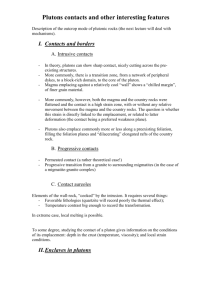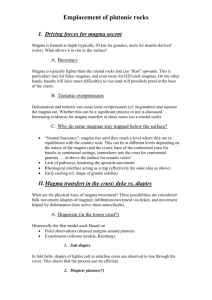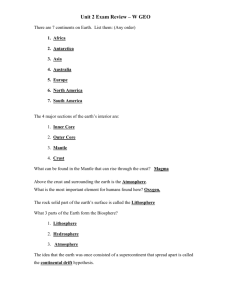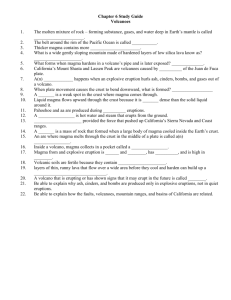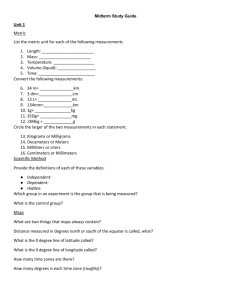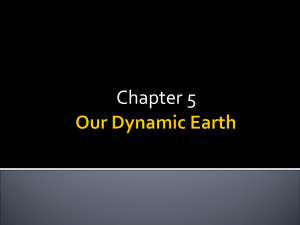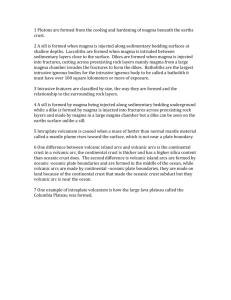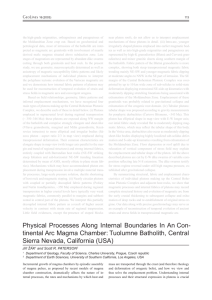Lecture W6-L15-17
advertisement
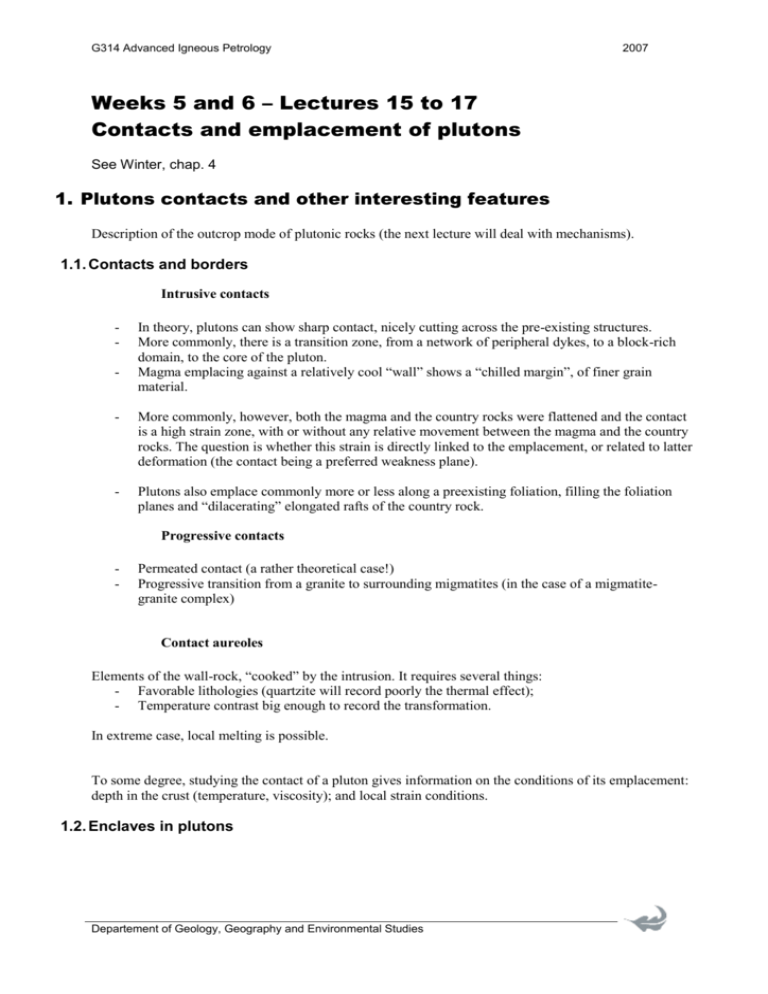
G314 Advanced Igneous Petrology 2007 Weeks 5 and 6 – Lectures 15 to 17 Contacts and emplacement of plutons See Winter, chap. 4 1. Plutons contacts and other interesting features Description of the outcrop mode of plutonic rocks (the next lecture will deal with mechanisms). 1.1. Contacts and borders Intrusive contacts - In theory, plutons can show sharp contact, nicely cutting across the pre-existing structures. More commonly, there is a transition zone, from a network of peripheral dykes, to a block-rich domain, to the core of the pluton. Magma emplacing against a relatively cool “wall” shows a “chilled margin”, of finer grain material. - More commonly, however, both the magma and the country rocks were flattened and the contact is a high strain zone, with or without any relative movement between the magma and the country rocks. The question is whether this strain is directly linked to the emplacement, or related to latter deformation (the contact being a preferred weakness plane). - Plutons also emplace commonly more or less along a preexisting foliation, filling the foliation planes and “dilacerating” elongated rafts of the country rock. Progressive contacts - Permeated contact (a rather theoretical case!) Progressive transition from a granite to surrounding migmatites (in the case of a migmatitegranite complex) Contact aureoles Elements of the wall-rock, “cooked” by the intrusion. It requires several things: - Favorable lithologies (quartzite will record poorly the thermal effect); - Temperature contrast big enough to record the transformation. In extreme case, local melting is possible. To some degree, studying the contact of a pluton gives information on the conditions of its emplacement: depth in the crust (temperature, viscosity); and local strain conditions. 1.2. Enclaves in plutons Departement of Geology, Geography and Environmental Studies G314 Advanced Igneous Petrology 2007 Enclaves linked to the source of the magma Microgranular mafic enclaves Reviewed in a previous lecture (magma mixing). They represent “bubbles” of a comagmatic liquid present in the granite. Restites Elements of the source. The difference with xenoliths is not always easy to make, in theory they should have a “restitic” nature (refractory, with no or little of the “fusible” components). Enclaves related to its emplacement. Xenoliths Bits and pieces of country rock. Can be either angular, rounded or elongated & dilacerated. They are in fact bits of the contact… Microgranular felsic enclaves Probably represent chilled margins of the pluton, latter broken and re-incorporated into the pluton Can you try to draw a sketch showing the emplacement features in 1. a upper-crustal pluton, emplaced in a low-strain domain, far from the source? 2. A lower-crustal pluton, emplaced in a high-strain area, close to its source? 2. Shape of plutons 2.1. How to study the shape of an intrusion? - Map pattern is generally not very useful (there are exceptions, however). The geometry of the wall rock can be misleading. Geophysics is the best tool. The internal strain pattern can be a good guide. 2.2. Shape of individual intrusions Flat intrusions - Sills Laccoliths Probably the most common shape! Cylindrical intrusions (or wedge-shaped) Only geophysics and 3D-drawings allow to tell… Departement of Geology, Geography and Environmental Studies G314 Advanced Igneous Petrology 2007 Conical and other “vertical” intrusions Mostly restricted to small intrusions, seldom applies to large complexes. 2.3. Role of the tectonic environment A first order approximation: intrusions are similar to “cracks” in the crust, and consequently reflect the stress field under which they emplaced. - Flat intrusions: 1 is the lithostatic pressure, 2 ≈ 3 - “Cylindrical” intrusions: 3 probably corresponds to 3, the main extension direction, 1 ≈ 2. - Conical/deep intrusions: obviously, 3 is vertical. Role of explosion/internal pressure? 2.4. Batholiths and intrusion clusters Batholith = collection of pluton. - Old literature: plutons with vertical wall, arriving at depth to an hypothetical mass of granite (batholith). - Modern geoglogy: batholiths are collection of plutons, maybe not very deep. The shape of each individual pluton can be discussed. 3. Driving forces for magma ascent Magma is formed at depth (typically 20 km for granites, more for mantle-derived rocks). What allows it to rise to the surface? 3.1. Buoyancy Magma is typically lighter than the crustal rocks and can “float” upwards. This is particulary true for felsic magmas, and even more for H2O-rich magmas. On the other hands, basalts will have more difficulties to rise (and will possibely pond at the base of the crust). 3.2. Tectonic overpressures Deformation and tectonic can cause local overpressures (cf. migmatites) and squeeze the magma out. Whether this can be a significant process or not is discussed… Increasing evidences for magma transfert in shear zones (on a crustal scale) 3.3. Why do some magmas stay trapped below the surface? “Neutral buoyancy”: magma rise until they reach a level where they are in equilibrium with the country rock. This can be at different levels depending on the nature of the magma (and the crust): base of the continental crust for basalts in continental settings, somewhere into the crust for continental granites … or above the surface for oceanic rocks! Lack of pathways, hindering the upwards movement Rheological interface acting as a trap (effectively the same idea as above) Early cooling (cf. shape of granite solidus) 4. Magma transfert in the crust: dyke vs. diapirs What are the physical ways of magma movement? Three possibilities are considered: bulk movement (diapirs of magma); infiltration/movement via dykes; and movement helped by deformation (into active shear zones/faults). Departement of Geology, Geography and Environmental Studies G314 Advanced Igneous Petrology 2007 4.1. Diapirism (in the lower crust?) Historically the first model used. Based on Field observations (sheared margins around plutons) Experiments (silicone models, Ramberg). Salt diapirs In fold belts, diapirs of lighter salt in anticline cores are observed to rise through the cover. This shows that the process can be efficient. Diapiric plutons(?) Many granitic plutons were thought to be diapiric, on the basis of their field relations. However, the viscosity of the upper crust is simply to high to allow for easy diapirism. It must be restricted to the lower crust, more ductile. Diapiric migmatite domes Migmatitic complexes (≈ metamorphic core complexes) do rise diapirically, or as tectonic-initiated domes originating in an extension situation. They can rise quite efficiently, especially if extension is present. But this seems to be more viable in the lower crust… or in very hot upper crust (therefore ductile) (postorogenic core complexes, cf. Eastern Mediterranean). 4.2. Upper crustal plutons Dyke-fed plutons and ballooning Upper crustal plutons appear to be flat-floored, sometimes with a feeder zone. This reflect the strain field during their emplacement. They were probably fed from below by dykes, tapping the magma into the pluton. These dykes are not always seen in the field (probably sealed by tectonics afterwards). The plutons therefore “inflate” in situ, not unlike an inflating balloon… The problem is, the pressure in the magma is probably not sufficient to open the space. The “room problem” How to make space to accommodate the pluton? - Assimilation of country rock (will actually not solve the problem…) - Bulging of the surface (seen in volcanoes, quite likely the ultimate process) - Deformation/tectonic movement (cf. experiments on fault-related plutons, especially in transtension). How to open “voids” in the crust? Magma overpressure is probably not enough (actually, it would probably make ring and cone dykes, see below…). Tectonics seems the only viable option. Numerous examples of fault-related plutons… Departement of Geology, Geography and Environmental Studies G314 Advanced Igneous Petrology 2007 4.3. The role of deformation Exploiting shear zones is an alternate way to bring the magmas to the surface. It’s basically quite similar to dykes, except that tectonic deformation in the shear zone will help to build the pressure and move the magmas upwards. At high structural levels, the shear zones will turn into faults, that can also be associated with pluton emplacement. On the field, this will result in close fault-granite association, either as melt-injected (and meltlubricated!) shear zones in the deep crust, or as fault-related plutons in the upper crust. 4.4. Ring dykes: transition towards volcanoes In sub-volcanic environements (brittle crust), dyking is the only possible alternative. A common feature is “ring dykes”, associated to caldera collapse and major volcanic eruptions (“cauldron subsidence”). Departement of Geology, Geography and Environmental Studies
